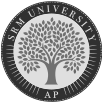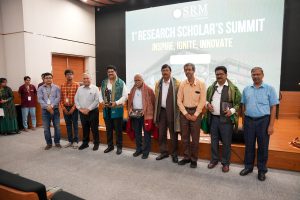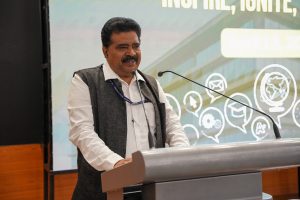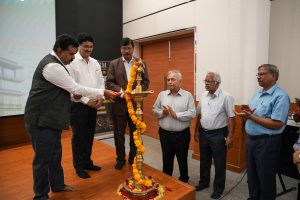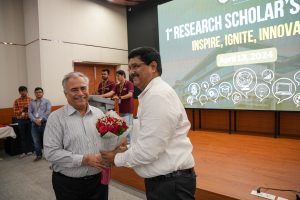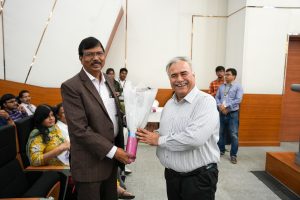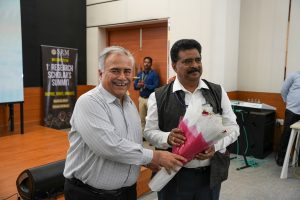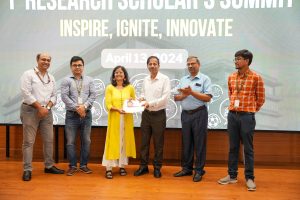Advancing Knowledge: Publication of Groundbreaking Research Paper
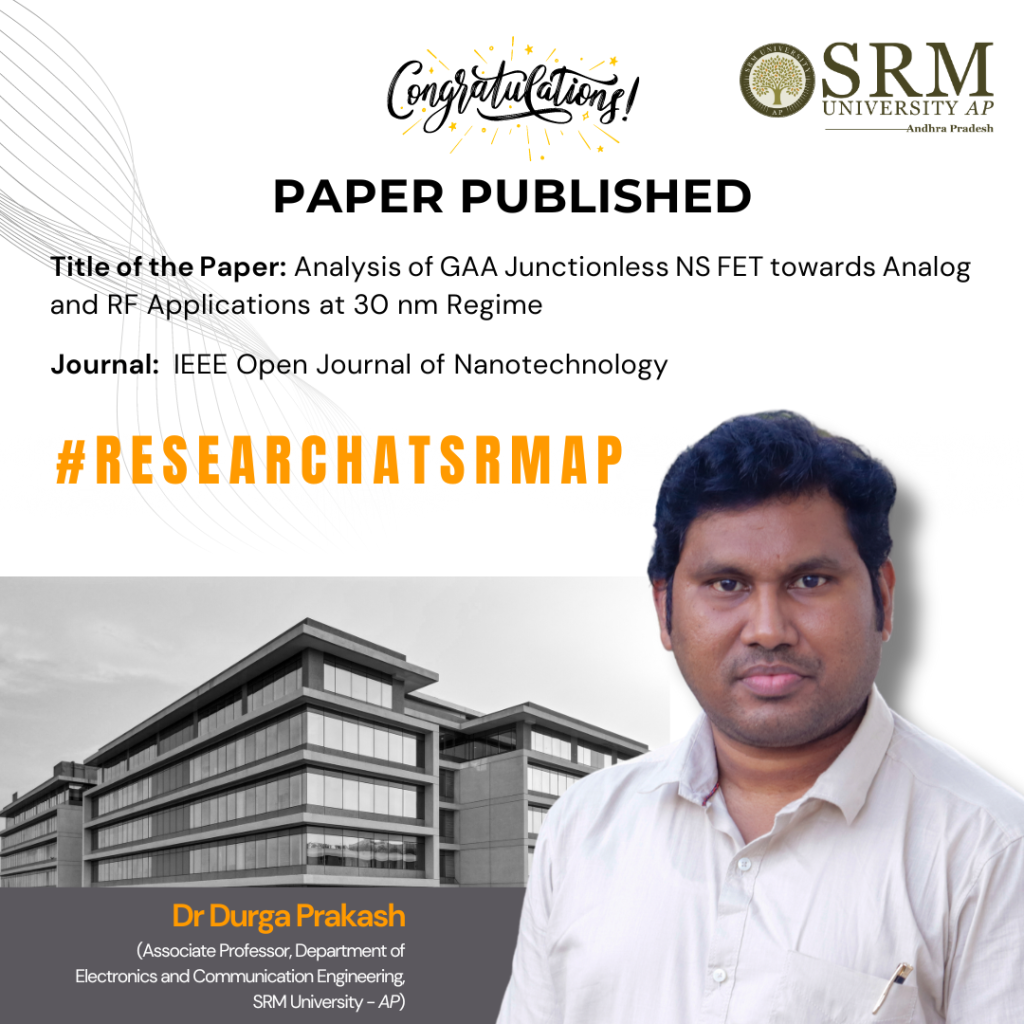
It is a matter of immense pleasure for the Department of Electronics and Communication Engineering to announce the publication of Dr Duga Prakash, Associate Professor at SRM University-AP. His research paper titled “Analysis of GAA Junctionless NS FET towards Analog and RF Applications at 30 nm Regime”, published in IEEE Open Journal of Nanotechnology, studies how the device can be manufactured with ease and minimal doping, eliminating the need for high-temperature doping processes. The enhanced performance metrics suggest that the device’s potential for faster analog/RF switching circuits paves the way for more efficient analog and RF applications at the 30 nm scale.
Abstract:
A new nanosheet FET is used to generate a quantum model in this research. A Gate-all-around (GAA) Junction-less (JL) nanosheet device with a 1 nm gate dielectric of SiO2 and HfO2 performs according to the standard model. The visual TCAD tool examines ION, IOFF, ION/ IOFF, threshold voltage, DIBL, gain parameters (gm, gd, Av), gate capacitance, and cut-off frequency to evaluate the classical and quantum models of the GAA nanosheet device. Simulation results show that the device’s low gate capacitance of 10–18 makes it suitable for rapid switching applications. Device research reveals a transconductance (gm) value of 21 μS and a remarkable cut-off frequency of 9.03 GHz. Its P-type device response has also been extensively studied. Finally, the inverter model uses the proposed GAA nanosheet device. Despite having larger gate capacitance, the NSFET-based inverter offers the smallest propagation delay helps apply knowledge to real-world situations.
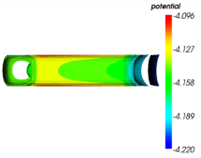
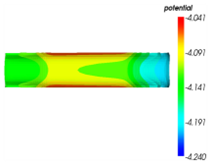
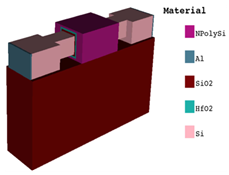
- Published in Departmental News, ECE NEWS, News, Research News
Exploring Contemporary Narratives in New Media
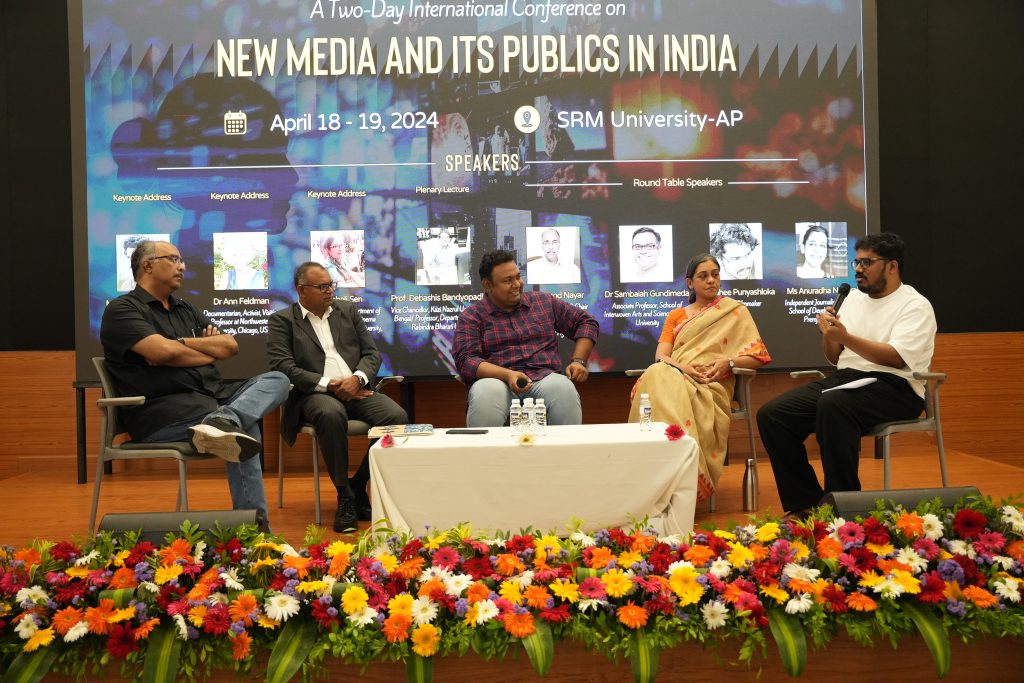
Department of Liberal Arts and the Department of Media Studies, under the aegis of the Easwari School of Liberal Arts at SRM University-AP organised its 2-day International Conference on New Media and its Publics in India. This prestigious conference welcomed renowned figures, including Mr Abhinandan Sekhri, co-founder and CEO of Newslaundry; Dr Ann Feldman, Documentarian and Activist; Dr Meheli Sen, Associate Professor, Department of AMESALL, Director of Cinema Studies Program, Rutgers University; Dr Pramod K Nayar, Professor and UNESCO Chair in Vulnerability Studies, Department of English, University of Hyderabad; Dr Sambaiah Gundimeda, Associate Professor, School of Interwoven Arts and Sciences, KREA University; Mr Rahee Punyashloka, Artist and Filmmaker and Ms Anuradha Nagaraj, Independent Journalist, Faculty at School of Development, Azim Premji University.
In his inaugural address, Vice Chancellor Prof. Manoj K Arora remarked, “We are honoured to host a conference of this magnitude. Media has become an indispensable facet of our contemporary existence; invariably, we all engage with or subscribe to media in some capacity.” Keynote speaker and co-founder of Newslaundry, Mr Abhinandan Sekhri, imparted his wisdom to the attendees, emphasising, “As the fourth pillar, media plays a pivotal role in society. It is imperative that we discern and uphold the principles of authentic journalism.” Prof. Vishnupad, Dean-Easwari School of Liberal Arts, remarked,” Technology and media have become an essential aspect of our lives today, and they have drastically altered our perception of things.”
Dr Meheli Sen, Dr Ann Feldman, Dr Pramod Nayar, Dr Sambaiah Gundimeda, Mr Rahee Punyashloka, and Ms Anuradha Nagarajan all deliberated on the various possibilities and interpretations that the New media offers and thereby shapes the public narratives. The conference also comprised a series of parallel sessions that explored the multifaceted relationship between New Media and various disciplines. Topics discussed included New Media and Literature, Gender, History, Democracy and Performance. Members of the academia presented their research papers, fostering insightful discussions on the evolving landscape of New Media.
The two-day event witnessed 150+ entries from students, scholars and faculties from across the country and the world and provided a platform for intellectual exchange but also fostered a collaborative spirit among participants. The conference concluded with a plenary address by Dr Pramod Nayar, which served as a catalyst for innovative thinking in New Media. Registrar Dr R Premkumar, in his message, applauded the efforts of the convenors, Dr Asijit Dutta and co-convenors Dr Sapna Mishra and Dr Partha Bhattacharjee for organising a scholarly colloquium such as this and remarked, “the exchange of ideas, scholarly debates, and interdisciplinary discussions that transpired here will undoubtedly enrich the academic landscape and advancement in the field of new media”.
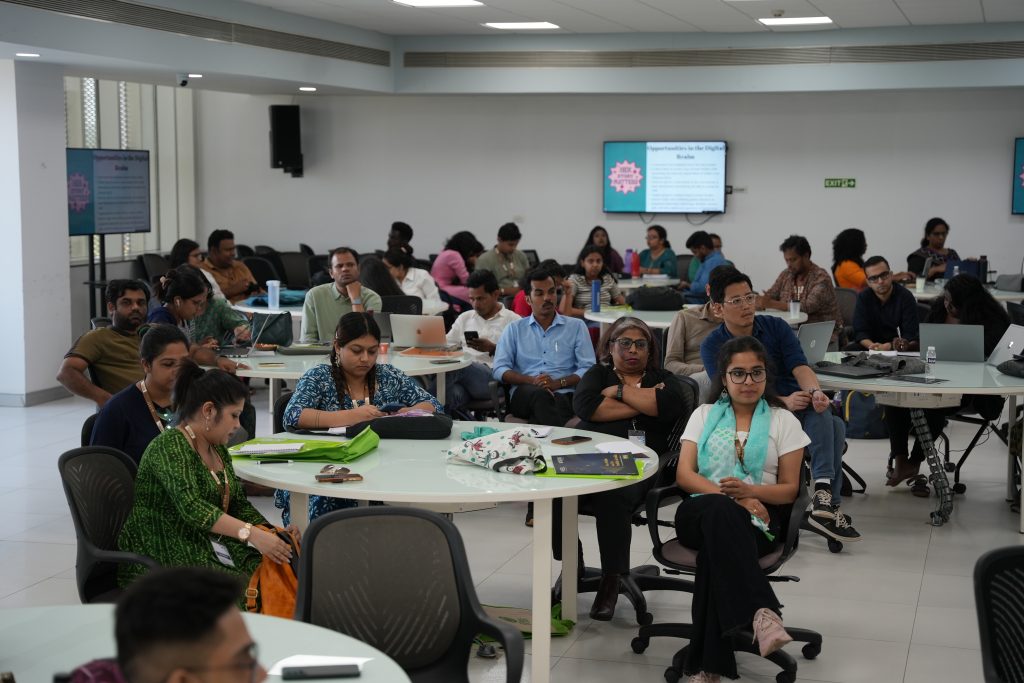
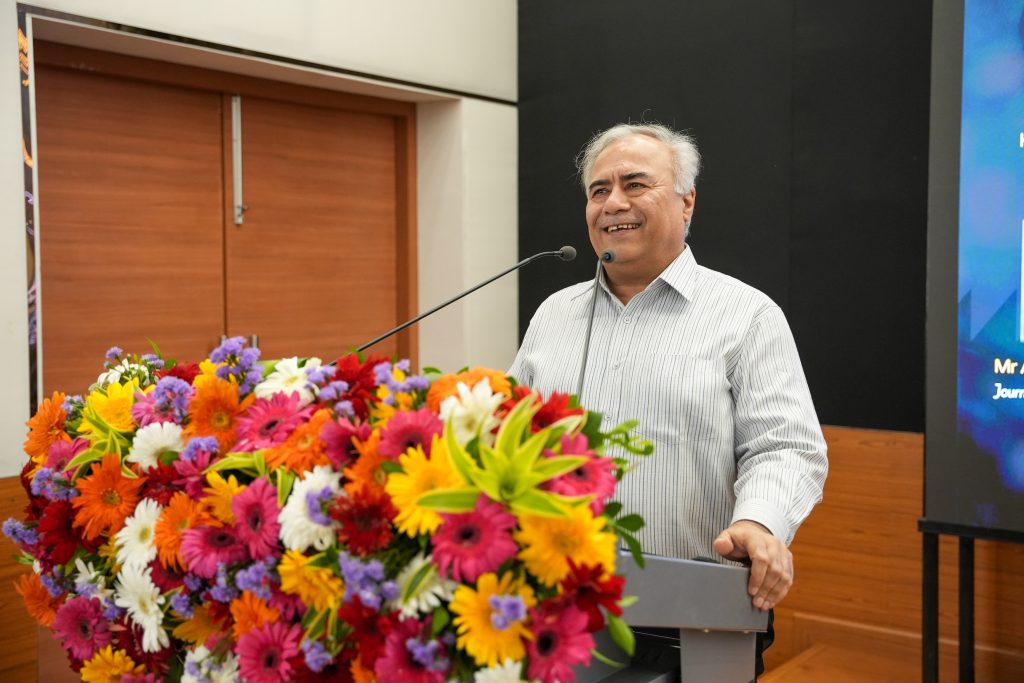
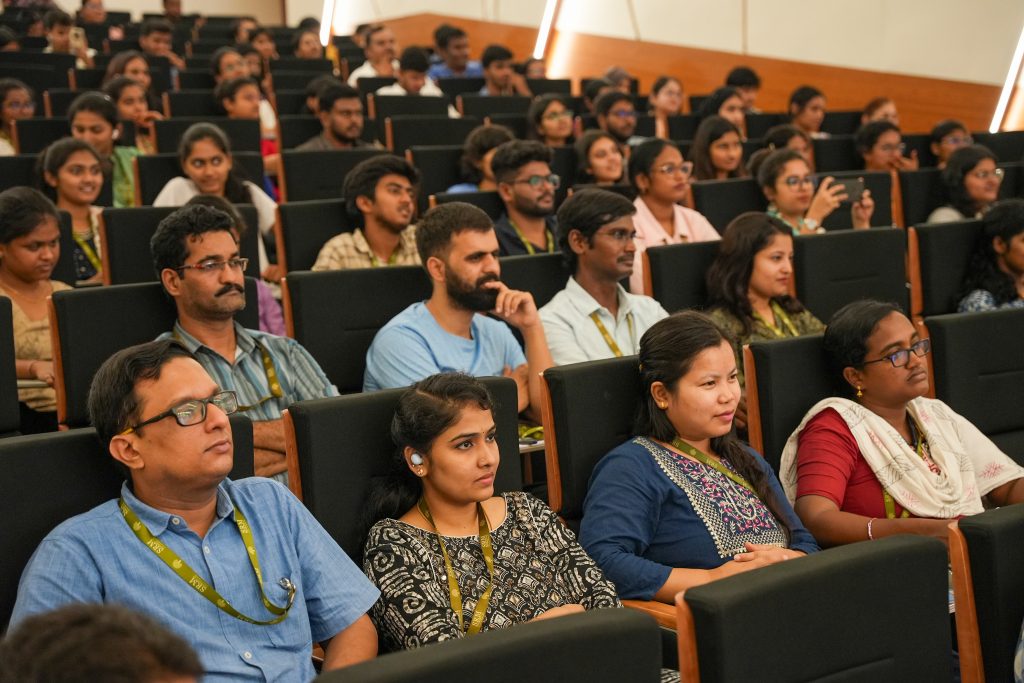
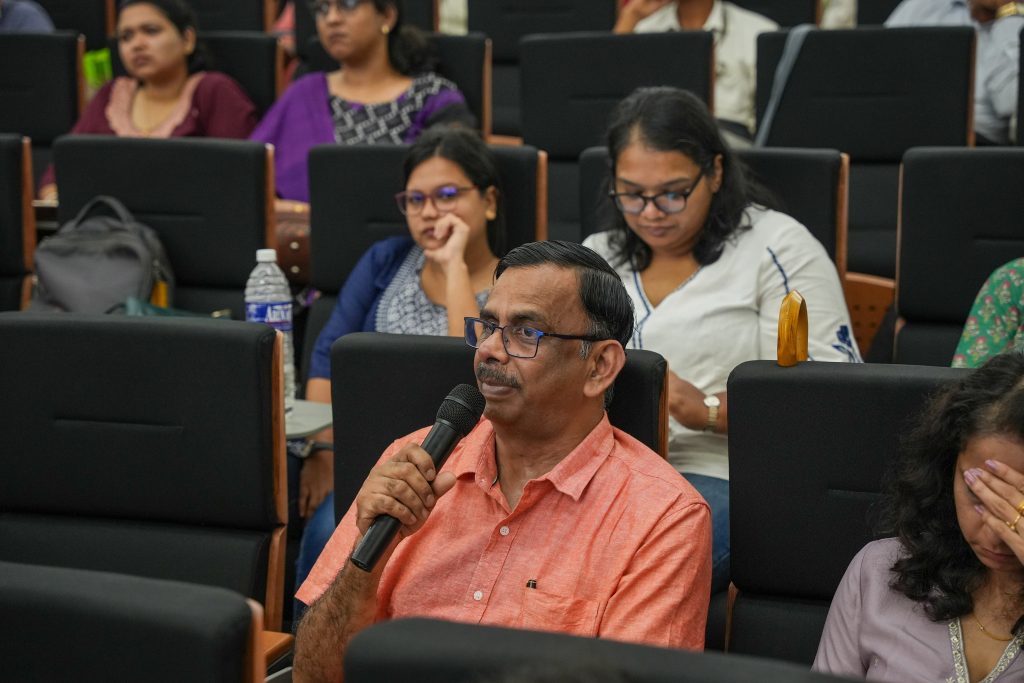
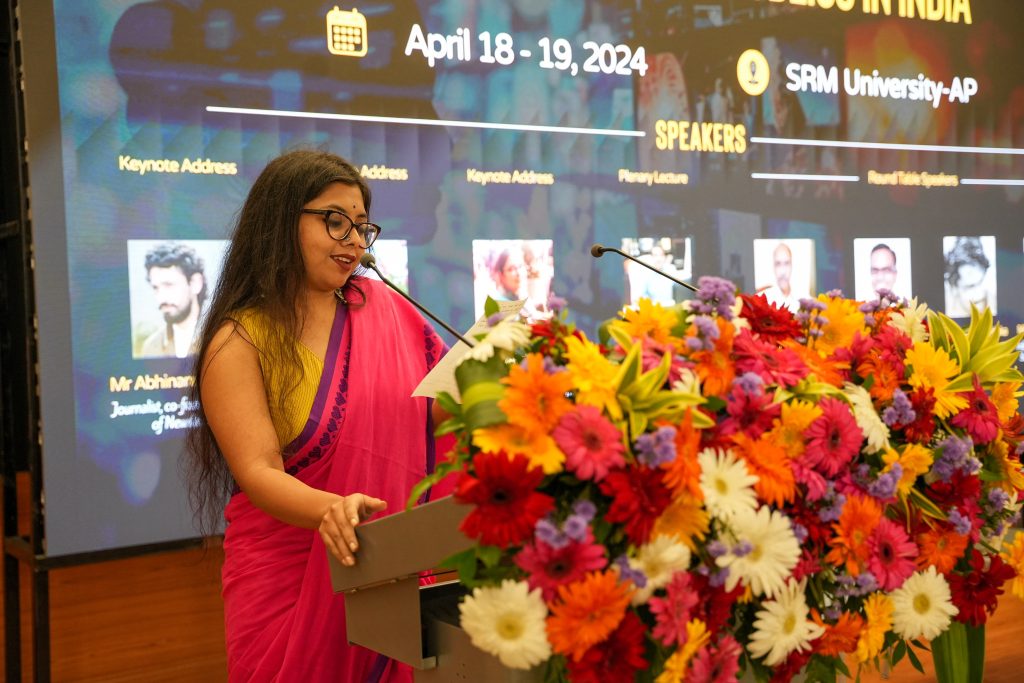
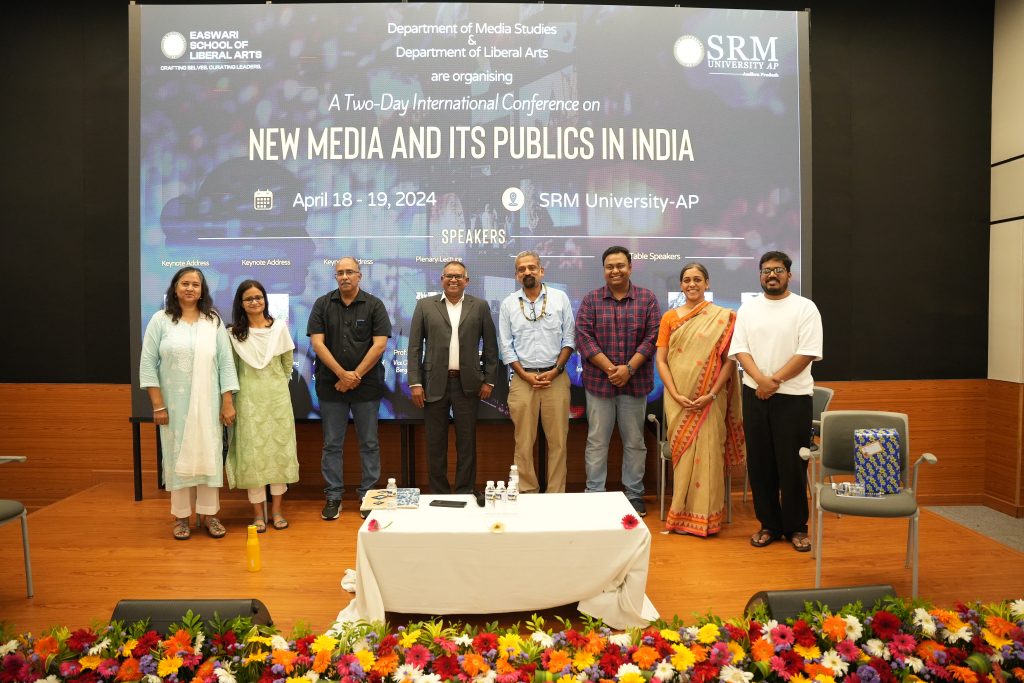
- Published in Departmental News, Liberal Arts News, Media Studies, News
Exploring Railway Bridges and Track Structure: Insights from Industry Professionals
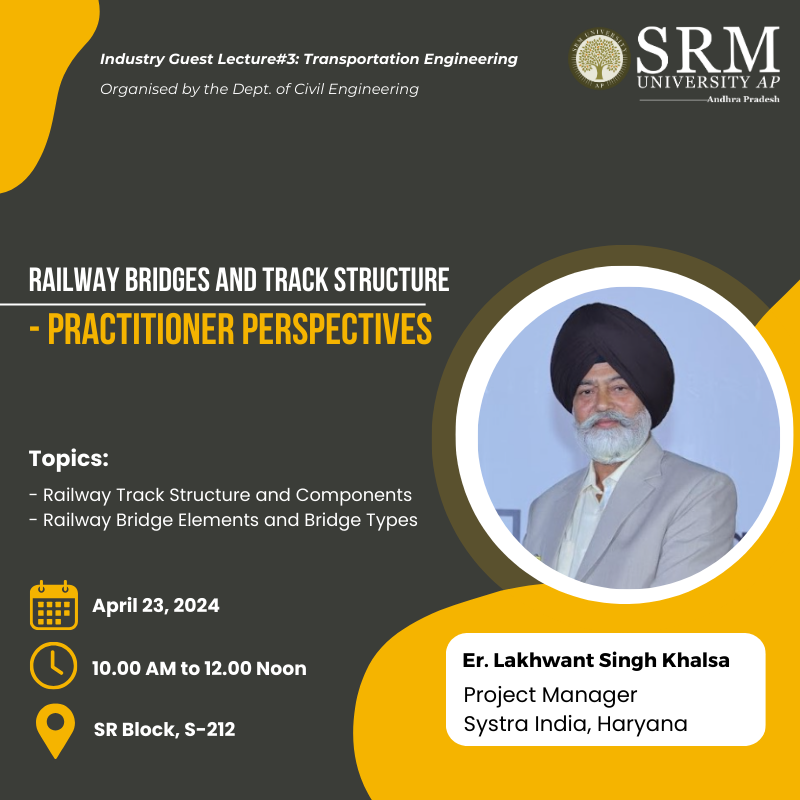
The Department of Civil Engineering is thrilled to host Er. Lakhwant Singh Khalsa for its 3rd Industry Guest Lecture Series. Mr Khalsa, Project Manager at Systra India, Haryana, will deliberate on “Railway Bridges and Track Structure – Practitioner Perspectives”. His lecture will offer deep insights into Railway Track Structure and Components and Railway Bridge Elements and Bridge Types. We Invite all civil engineering students and enthusiasts to join the insightful session on April 23, 2024.
About the Speaker:
Er. Lakhwant Singh Khalsa currently working as a project manager, Systra/PMC for RVNL Vijayawada 3rd line rail project. He has 41 years of rich & extensive experience in railway steel bridge structures, civil bridge works and project management. He is a Life Member of the Institution of Permanent Way Engineers (India)-IPWE and the Indian Institution of Bridge Engineers-IIBE. He holds several prestigious certifications, such as welding inspector from the welding research institute BHEL Trichy and Level II Certification in Non-Destructing Testing for DPT, MPT & UT as per SNT TC IA2006. He is familiar with IS, IRS, EN, and BS Codes, which are relevant to steel and concrete works. Also, he has experience working in hilly terrains in the Himalayan Ranges with critical environmental conditions.
- Published in Civil Engg events, Departmental Events, Events
Research Paper on Computing In-memory Reconfigurable Adder Design
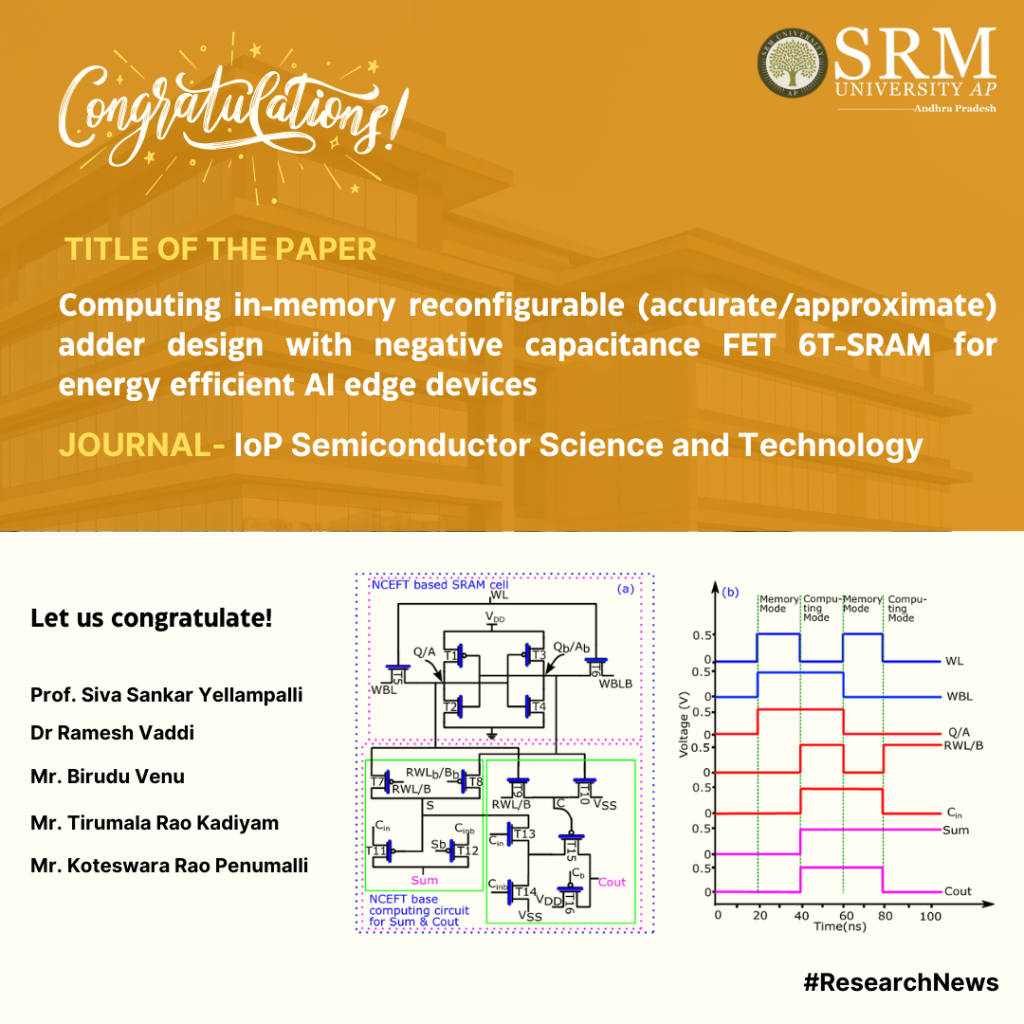
Prof. Siva Sankar Yelampalli and Dr Ramesh Vaddi, Associate Professor, from the Department of Electronics and Communication Engineering, along with research scholars Mr Birudu Venu, Mr Tirumala Rao Kadiyam, and Mr Koteswara Rao Penumalli, have jointly published a paper titled “Computing in-memory reconfigurable (accurate/approximate) adder design with negative capacitance FET 6T-SRAM for energy efficient AI edge devices” The paper introduces Computing in-memory (CiM) as a promising alternative to traditional von-Neumann architectures, focusing on its potential for energy-efficient AI edge computing with CMOS scaling. Additionally, they have explored the advancements in approximate computing in-memory (ACiM) techniques, aiming to further enhance the energy efficiency of these innovative architectures.
Abstract:
Computing in-memory (CiM) is an alternative to von Neumann architectures for energy-efficient AI edge computing architectures with CMOS scaling. Approximate computing in-memory (ACiM) techniques have also been recently proposed to further increase the energy efficiency of such architectures. In the first part of the work, a negative capacitance FET (NCFET) based 6T-SRAM CiM accurate full adder has been proposed, designed and performance benchmarked with equivalent baseline 40 nm CMOS design. Due to the steep slope characteristics of NCFET, at an increased ferroelectric layer thickness, Tfe of 3 nm, the energy consumption of the proposed accurate NCFET-based CiM design is ∼82.48% lower in comparison to the conventional/Non CiM full adder design and ∼85.27% lower energy consumption in comparison to the equivalent baseline CMOS CiM accurate full adder design at VDD = 0.5 V. This work further proposes a reconfigurable computing in-memory NCFET 6T-SRAM full adder design (the design which can operate both in accurate and approximate modes of operation). NCFET 6T-SRAM reconfigurable full adder design in accurate mode has ∼4.19x lower energy consumption and ∼4.47x lower energy consumption in approximation mode when compared to the baseline 40 nm CMOS design at VDD = 0.5 V, making NCFET-based approximate CiM adder designs preferable for energy efficient AI edge CiM based computing architectures for DNN processing.
Future research plans: Implementing reconfigurable computing in-memory (CiM) MAC for energy-efficient AI edge devices.
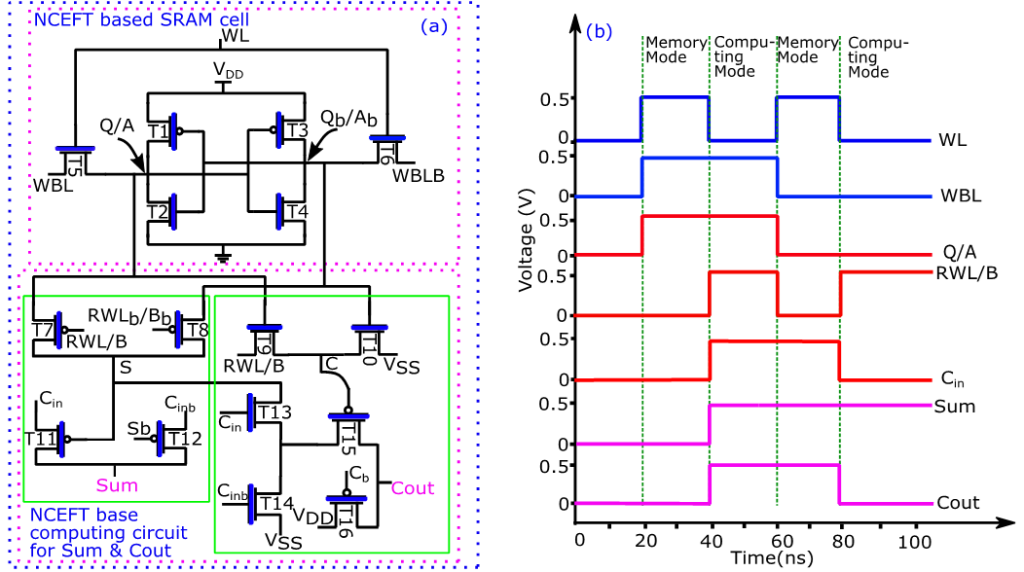
- Published in Departmental News, News, Research News
Examining the Impact of Bifurcation on Agricultural Development in Jharkhand: A Comprehensive Study
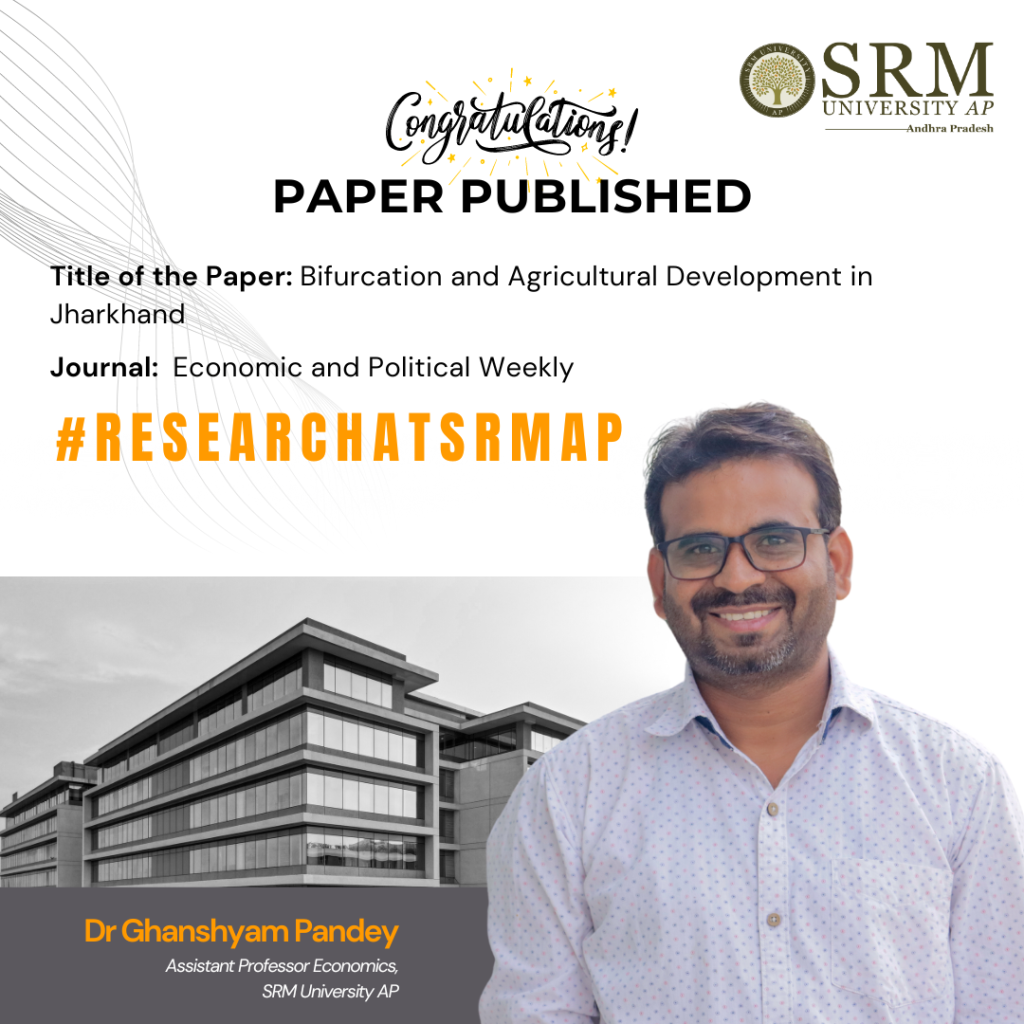
The Department of Economics is thrilled to announce the publication of Assistant Professor Dr Ghanshyam Kumar Pandey’s research paper titled, “Bifurcation and Agricultural Development in Jharkhand,” in Economic and Political Weekly. The paper delves into the developmental trajectory of Jharkhand following its bifurcation from Bihar in 2000 and examines the intricacies of agricultural development and the key determinants that have shaped its evolution post-separation.
Abstract:
The cropping pattern in Jharkhand has significantly changed from 2000 to 2016, with shifts from the cultivation of cereals to non-cereals. An increase in the crop area and diversification towards high-value crops have accelerated overall agricultural growth. Capital formation and better infrastructure facilities, along with improved fertiliser consumption and irrigation, will foster agricultural development in Jharkhand
Practical implementation:
This study shows the development path of Jharkhand after bifurcation from Bihar in 2000. The study deals with the process of agricultural development and determinants of agricultural development after its bifurcation.

- Published in Departmental News, Economics Current Happenings, Economics News, News, Research News
Revolutionising Energy Harvesting: Dr Banee Banadana Receives Patent for Innovative System
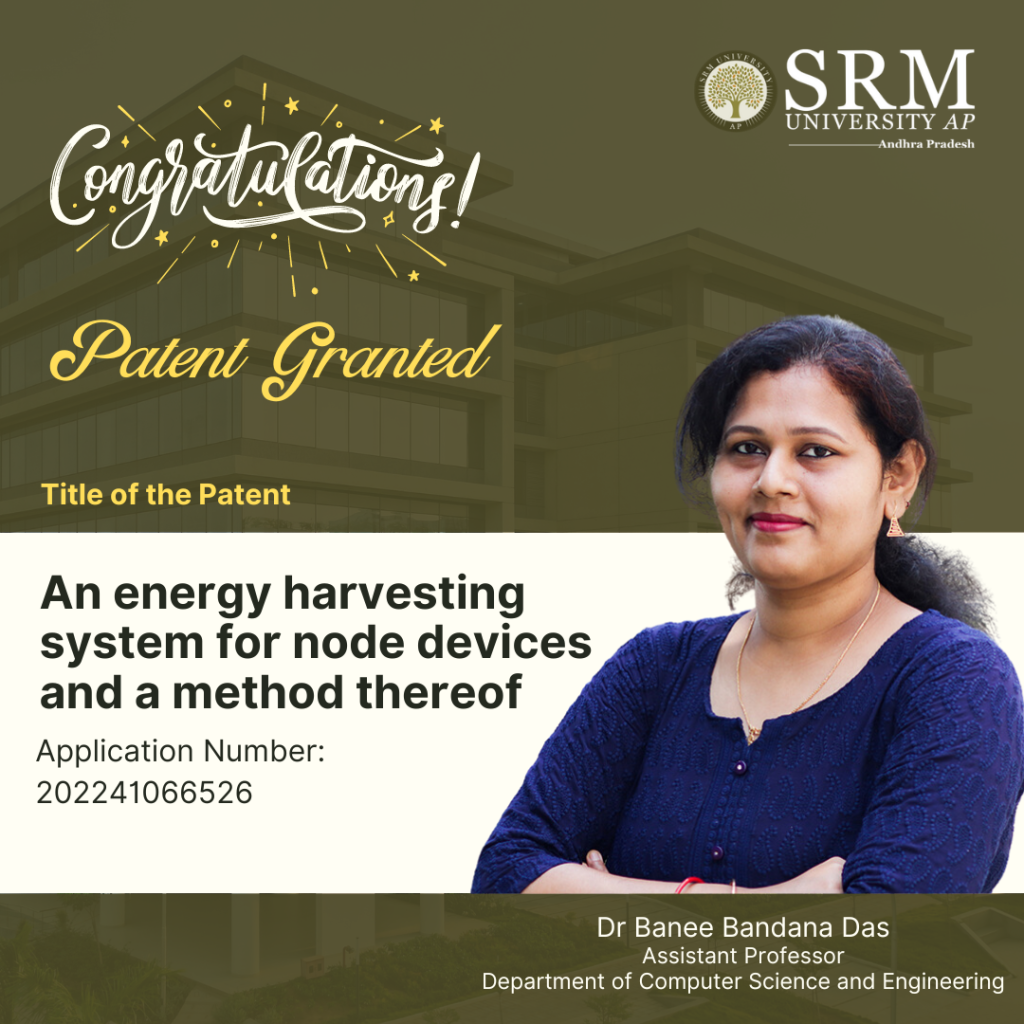
Dr Banee Bandana Das, Assistant Professor in the Department of Computer Science and Engineering, has achieved a remarkable milestone. The invention titled “An Energy Harvesting System for Node Devices and a Method Thereof” has been granted a patent by the Patent Office Journal, under Application Number: 202241066526. This achievement marks a significant leap forward in the realm of energy harvesting systems, promising a brighter and more secure future for IoT applications.
Abstract
The present invention is broadly related to design of secure and Trojan Resilient energy harvesting system (EHS) for IoT end node devices. The objective is to develop a state-of-the-art energy harvesting system which can supply uninterrupted power to the sensors used in IoT. The EHS is self-sustainable. The higher bias voltages are generated on chip. The system is mainly consisting of security module, power conditioning module, Trojan Resilient module, and load controller module. The power failure of the sensors used in IoT may leads to information loss thereby causing catastrophic situations. An uninterrupted power supply is a must for smooth functioning of the devices in IoT. This invention caters secure power requirements with security issues of IoT end node devices.
Practical Implementation:
The IoT end node devices needs 24*7 power supply and are very sensitive to attacks made by adversaries before and after fabrication. This invention takes care of the power requirement of end node devices with green energy and secure the EHS-IC from adversaries and attacks and therefore can be used by individuals, as powering sensors at remote locations and as part of smart agriculture.
Future research plans:
Design more secure and reliable design for making a IoT smart node smarter and self-Sustainable. Exploring more circuit level techniques and find new way to design more power efficient designs.
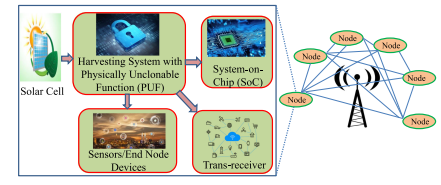
- Published in Computer Science News, CSE NEWS, Departmental News, Research News
Dr Banee Bandana Das, Assistant Professor in the Department of Computer Science and Engineering, has achieved a remarkable milestone. The invention titled “An Energy Harvesting System for Node Devices and a Method Thereof” has been granted a patent by the Patent Office Journal, under Application Number: 202241066526. This achievement marks a significant leap forward in the realm of energy harvesting systems, promising a brighter and more secure future for IoT applications.
Abstract
The present invention is broadly related to design of secure and Trojan Resilient energy harvesting system (EHS) for IoT end node devices. The objective is to develop a state-of-the-art energy harvesting system which can supply uninterrupted power to the sensors used in IoT. The EHS is self-sustainable. The higher bias voltages are generated on chip. The system is mainly consisting of security module, power conditioning module, Trojan Resilient module, and load controller module. The power failure of the sensors used in IoT may leads to information loss thereby causing catastrophic situations. An uninterrupted power supply is a must for smooth functioning of the devices in IoT. This invention caters secure power requirements with security issues of IoT end node devices.
Practical Implementation:
The IoT end node devices needs 24*7 power supply and are very sensitive to attacks made by adversaries before and after fabrication. This invention takes care of the power requirement of end node devices with green energy and secure the EHS-IC from adversaries and attacks and therefore can be used by individuals, as powering sensors at remote locations and as part of smart agriculture.
Future research plans:
Design more secure and reliable design for making an IoT smart node smarter and self-Sustainable. Exploring more circuit level techniques and find new way to design more power efficient designs.
- Published in Computer Science News, CSE NEWS, Departmental News, Research News
1st Research Scholar’s Summit: A Symposium of Ideas and Innovation
“The very idea of a platform such as this is to promote multidisciplinary collaborative research,” emphasised Prof. K Hemachandra Reddy, Chairman, Andhra Pradesh State Council of Higher Education (APSCHE), encapsulating the spirit of the 1st Research Scholar’s Summit hosted at SRM University-AP in partnership with the Government of Andhra Pradesh. The event was staged to reinforce research within academic circles and herald a new phase of learning. The summit was attended by esteemed dignitaries like Prof. Korukonda Babji, Vice Chancellor Dr Y S R University of Health Sciences; Prof. Ramesh Srikonda, Director-School of Planning and Architecture; Dr M Balakrishnan, IIT, Delhi, along with Vice Chancellor, Prof. Manoj K Arora; Registrar, Dr R Premkumar, Deans, Faculty, and Students.
In his keynote address, Vice Chancellor Prof. Arora emphasised the pivotal role of such summits in fostering a conducive environment. He stated, “We live in a world of collaborations, and a summit like this gives an opportunity to interact, establish partnerships and forge scholarly excellence”. He highlighted the varsity’s research acumen in the form of patents, technology transfers, research publications, start-ups, and incubations. He also declared that the varsity would be open to sharing its state-of-the-art research infrastructure among the broader demography in order to foster a research mindset among all.
Prof. Ranjit Thapa, Dean-Research at the university, highlighted the participation of 150 PhD scholars from diverse institutions. His speech reflected the tireless commitment to building the university’s scientific fortitude. Prof. Srikonda underscored the significance of technological advancement and innovation. He praised the summit for being a stage that will offer pragmatic solutions to societal challenges and commended its tagline – “Inspire, Ignite, Innovate,” for aligning with its core objectives.
Prof. Korukonda Babji and Prof. M Balakrishnan, pivotal figures in academia, articulated the transformative role of cutting-edge research in elevating society. They emphasised the potential of such forums in catalysing groundbreaking changes in research.
The summit showcased presentations from doctoral scholars, encompassing 60 poster presentations and 90 oral presentations, organised across 8 thematic areas. The summit concluded with a valedictory function, and tokens of appreciation were presented to the dignitaries by the Vice Chancellor, Registrar, Deans, and convenors, Dr Ramanjaneya Reddy and Dr Sabyasachi Chakrabortty, and members of the organising committee.
- Published in News, Research Conferences, Research News
Reimagining Island Poetics: Seminal Research on N S Madhavan’s Novel
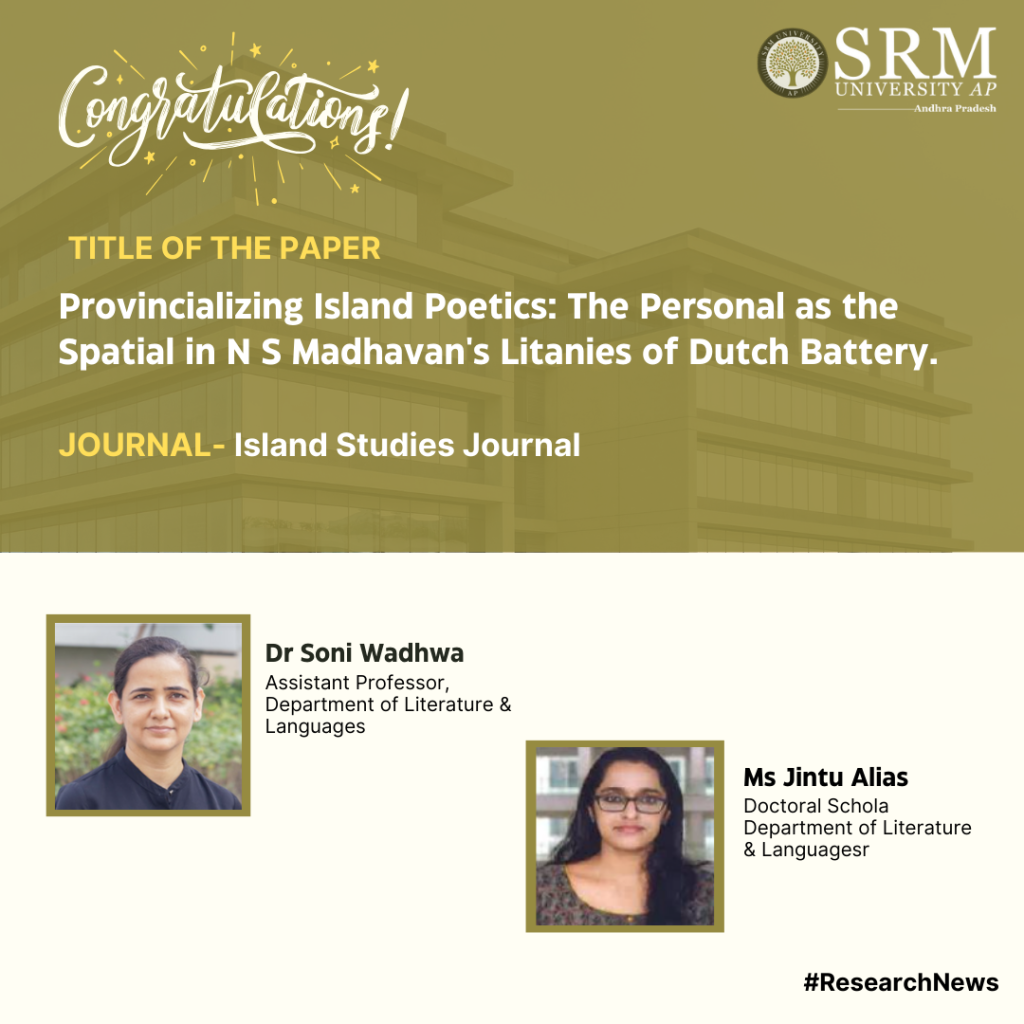
Dr Soni Wadhwa, Assistant Professor at the Department of Literature and Languages and her research scholar, Ms Jintu Alias, from the Easwari School of Liberal Arts at SRM University-AP, have published their seminal research paper titled “Provincialising Island Poetics: The Personal as the Spatial in N S Madhavan’s Litanies of Dutch Battery.”
Their research delves into the intricate relationship between personal experiences and spatial representations, challenging traditional island narratives. Focusing on the island city of Kochi and its rich history of cosmopolitanism, they aim to draw attention to alternative island spaces in India and Asia. Furthermore, they are convinced that their work will inspire further studies and creative writing on cultural traditions in smaller Indian island cities, highlighting the diverse themes and settings that are yet to be explored in Indian literature.
Abstract
Affect towards islands is a unique approach to engage with in discussions of the phenomenology of fictional islands. This affect complements the already identified tropes within island poetics: those of sensorial exploration, spatial practices, and textural detailing of islands. This article turns to a work of fiction about a fictional island based on the island city of Kochi in south India to unpack an alternative aesthetic of spatiality, the kind that changes the personal/political relationship to personal/spatial one. We argue that the novel, Litanies of Dutch Battery (the novel in question) by N.S. Madhavan, expands inquiries into phenomenology of fictional islands by making space for corporeal memory and collective memory in storytelling. These memory-oriented narrative devices, we suggest, “provincialize” island poetics to add a hermeneutic of postcolonial angst to the repertoire of formal features of literary islandness.
Link to the Article
https://doi.org/10.24043/001c.94614
We wish the pair continued success in their future endeavours!
- Published in Departmental News, English Current Happenings, News, Research News
Stanford University Professor Highlights Liberal Arts Education in India
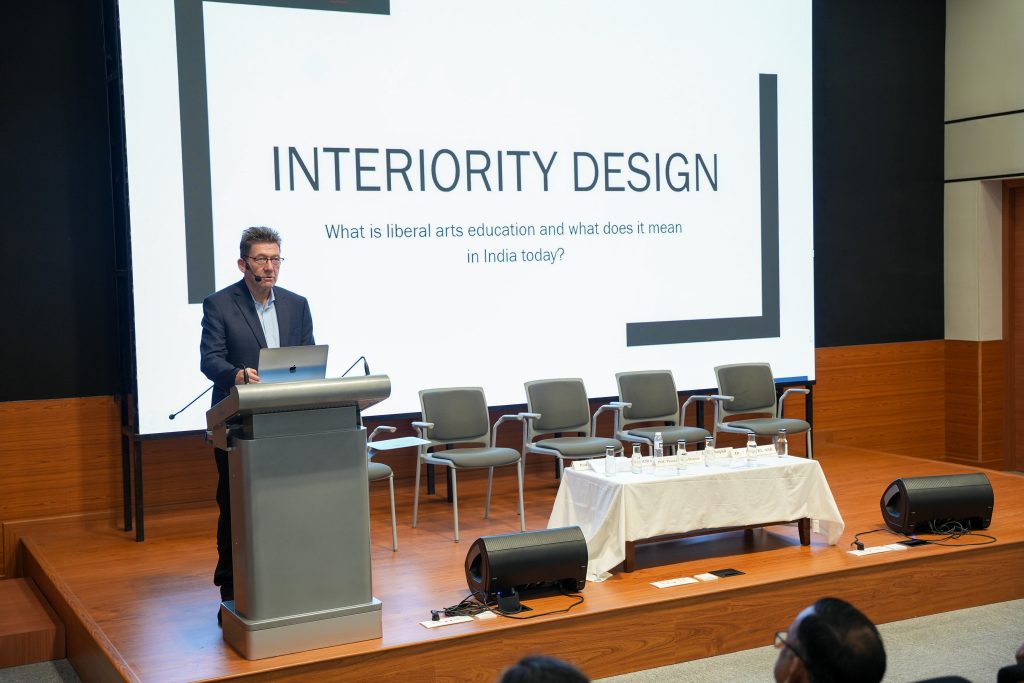
SRM University-AP convened the 18th chapter of its esteemed University Distinguished Lecture (UDL) series under the auspices of the Easwari School of Liberal Arts. This enlightening session showcased the expertise of Prof. Thomas Blom Hansen, the Reliance-Dhirubhai Ambani Professor & Department Chair, Department of Anthropology School of Humanities and Sciences Stanford University, USA. The lecture delved into the topic of “Interiority Design: Liberal Arts Education in India,” providing insights into the evolving landscape of liberal arts education within the Indian context.
Manoj K Arora stated, “We are a university that provides unique learning experiences; this UDL is part of that learning.” His insightful address underscored the significance of liberal arts and interdisciplinary learning.
During the lecture, Prof. Thomas Blom Hansen remarked on the need for liberal arts education in India to shape well-rounded individuals capable of addressing multifaceted challenges and embracing diverse perspectives. Prof. Hansen’s remarks emphasised the relevance and transformative potential of liberal arts education, enabling students to introspect and cultivate a deeper understanding of the world around them.
The 18th chapter of the University Distinguished Lecture (UDL) concluded with an interactive Q&A session. A token of appreciation was presented to Thomas Blom Hansen by Prof. Vishnupad, Dean-Easwari School of Liberal Arts, along with Prof. Ranjit Thapa, Dean-Research; Prof. G S Vinod Kumar, Professor and Head, Department of Mechanical Engineering; Dr Ayesha Parveen Haroon, Head and Assistant Professor, Department of Psychology; Dr J P Raja Pandiyan, Assistant Professor-Department of Chemistry. The event also saw the presence of Registrar Dr R Premkumar, Prof. Jayaseelan Murugaiyan and Prof. Vandana Swami, among others.
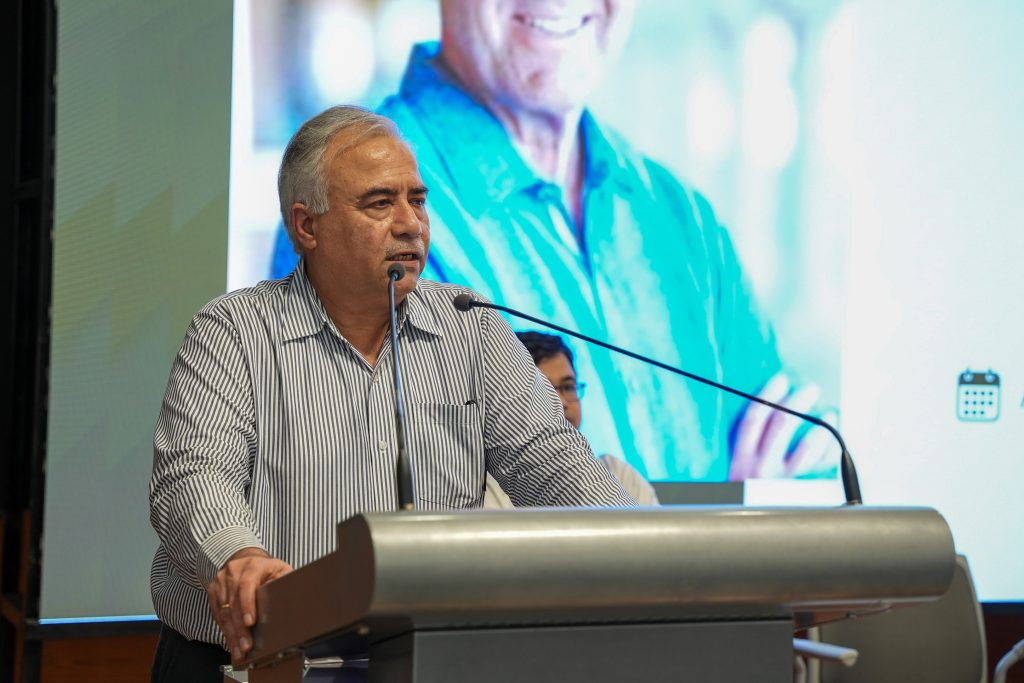
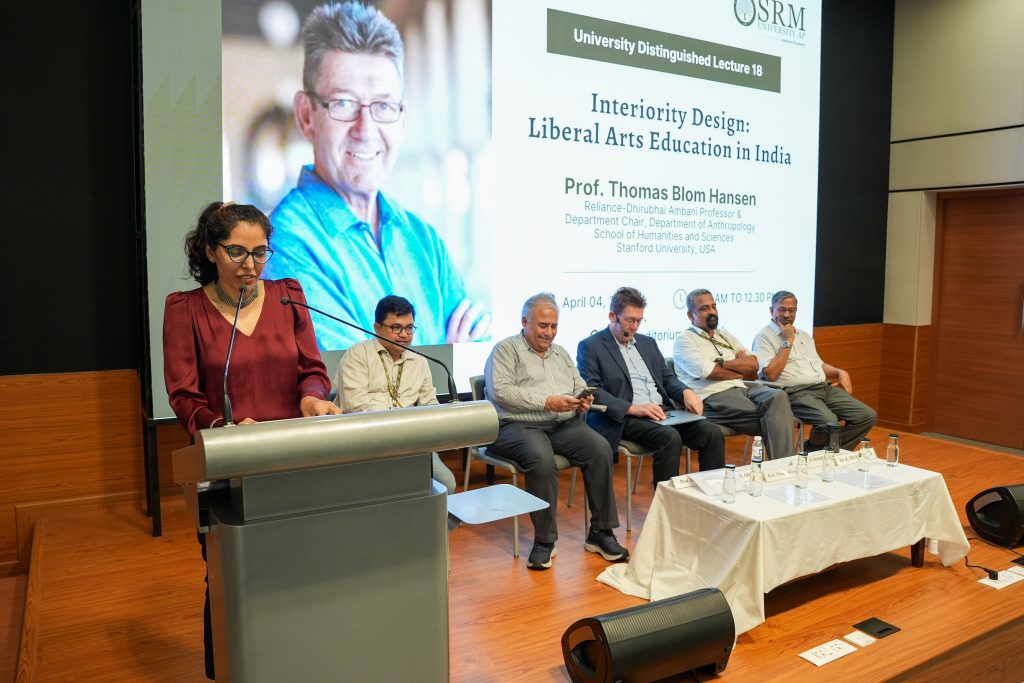
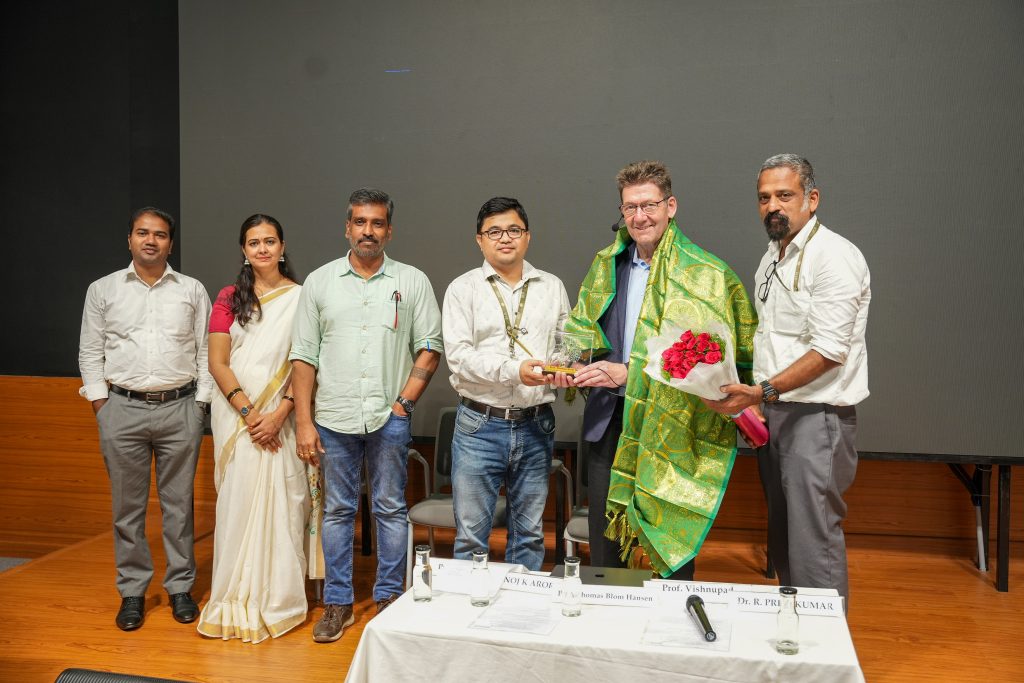
- Published in Departmental News, News, University Distinguished Lecture

